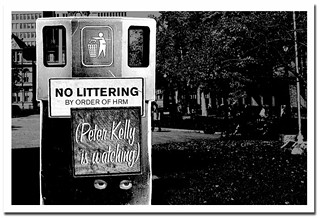Every April since 2000, mayor Peter Kelly has kicked off a “community clean-up campaign” on behalf of the city. Sometimes the campaigns come with snappy slogans (“Put Litter in its Place!”), sometimes they’ve been coordinated with non-profit group Clean Nova Scotia and sometimes they’ve had a specific focus, like cleaning the Sackville River in 2004. With this year’s campaign already underway (“Can You Afford to Litter?—Slam Dunk Your Junk!”), 2006 is no different.
Except it is—at least according to Solid Waste Resources manager Jim Bauld. Unlike campaigns of the past that simply focused on a two-month push to pick up trash, Bauld says that the 2006 campaign is more ambitious and has a broader focus.
“Each year, we’ve always had this litter campaign, but that was more of a Band-Aid approach,” he says. “This year, we’re trying to heighten the awareness and the social responsibility of citizens. It’s more than just a simple clean-up campaign.”
According to Bauld, to encourage citizens to feel responsible for littering, the city must also be responsible by providing them adequate facilities—in other words, giving people more places to drop off their junk.
“In order to enhance the aesthetics of the downtown and keep it a vibrant, clean place for walking and business and tourists, we determined that we need more litter baskets,” he says. “But to build on those new baskets once they’re in place, we need to build on public awareness and make sure that there are repercussions for those who don’t follow the rules.”
The current penalty for littering is hefty—$445 is the maxium fine under provincial law. And although the 2006 clean-up campaign doesn’t specifically address the need for new waste cans, Marion Currie, with the city’s Capital District, is doing something about the problem. Over the past year, 60 new cans were added to the Capital District, and Currie is hoping more are on the way.
“In 2004, the city had a streetscape design study, and the contractor made a recommendation that the city should have at least three cans per block within the Capital District,” she says. “We currently have at least one. And so our goal is to implement at least those minimum standards.”
The Capital District is also in the process of researching a waste bin design that can accommodate four-source separation—bins that would separate waste into organics, recyclables, mixed paper and refuse. The city currently has a handful of four-source separation bins in parks and open spaces around the city, but Currie notes that the physical size of the bins makes them impractical for wider use.
“There doesn’t seem to be a design out there that is appropriate for the sidewalks. The ones that we’ve already purchased are wonderful, except they’re quite large, and so to put those in smaller, high-traffic sidewalk areas where there’s already a lot of infrastructure—the benches, the light poles, the parking metres—it’s a matter of, how do they fit?
“Truthfully, for the last year, we’ve been trying to research what exists out there for good design around four-source within the right of way, and haven’t really found anything.”
While Currie can’t say exactly how many new bins will appear in the downtown area this year, she does predict the appearance of another downtown litter-fighting tool: ride-on street sweepers.
“We leased a model last year which worked well, so now we’re purchasing more; we’ll have one for the Dartmouth side, one for the Halifax side and three others for other communities—Bedford, Sackville, that sort of thing,” she says. “They can go up on sidewalk and pick up the minute pieces of garbage, even between the cracks in the sidewalk...we’re hoping to see the new models sometime in the next few months.”
Bins and sweepers aside, Currie feels that awareness is the greater factor contributing to a local litter problem.
“This is not just a city staff issue. This is everybody’s issue. This is a maintenance staff issue, this is a business owners issue, this is an issue for people who are walking down the street and have garbage in their hand, and it can only work if everyone is participating and feels as if it’s their responsibility, jointly.”











